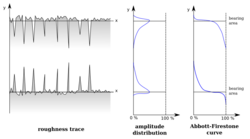Physics:Abbott-Firestone curve
The Abbott-Firestone curve or bearing area curve (BAC) describes the surface texture of an object. The curve can be found from a profile trace by drawing lines parallel to the datum and measuring the fraction of the line which lies within the profile.[1]
Mathematically it is the cumulative probability density function of the surface profile's height and can be calculated by integrating the probability density function.[2]
The Abbott-Firestone curve was first described by Ernest James Abbott and Floyd Firestone in 1933.[3][4] It is useful for understanding the properties of sealing and bearing surfaces. It is commonly used in the engineering and manufacturing of piston cylinder bores of internal combustion engines.[5] The shape of the curve is distilled into several of the surface roughness parameters, especially the Rk family of parameters.
References
- ↑ Johnson, K. L. (1985). Contact Mechanics. Cambridge University Press. pp. 407. ISBN 0-521-34796-3.
- ↑ Stachowiak, G. W.; Batchelor, A. W. (2001). Engineering tribology. Boston: Butterworth-Heinemann. pp. 450. ISBN 0-7506-7304-4.
- ↑ Abbott, E.J.; F.A. Firestone (1933). "Specifying surface quality: a method based on accurate measurement and comparison". Mechanical Engineering 55: 569–572. https://archive.org/details/sim_mechanical-engineering_1933-09_55_9/page/569/mode/1up?view=theater.
- ↑ "College of Engineering: Announcement 1934–1935 and 1935–1936". University of Michigan Official Publication (University of Michigan) 35 (55). June 1934. http://deepblue.lib.umich.edu/bitstream/2027.42/122636/1/39015094743583.pdf.
- ↑ Flitney, Robert (26 September 2007). Seals and Sealing Handbook, Fifth Edition. Elsevier Science. pp. 484. ISBN 978-1-85617-461-9.
 |


